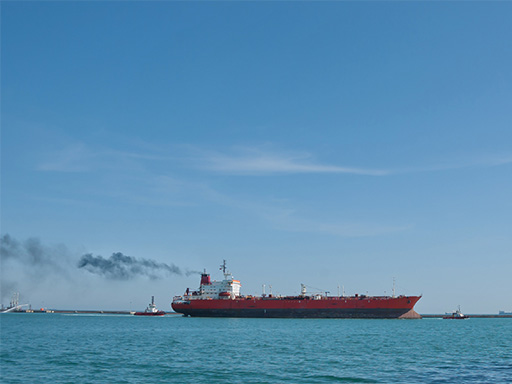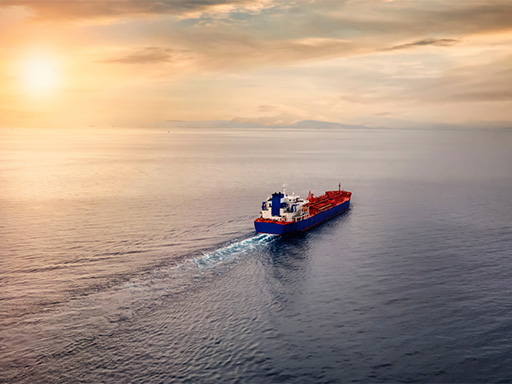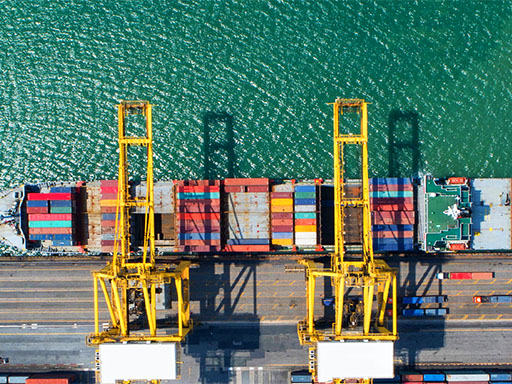FAQ - Monitoring, reporting and verification of maritime transport emissions
The following questions and answers are intended to guide shipping professionals in understanding the revised EU Monitoring, Reporting and Verification (MRV) Maritime Regulation. They do not replace the legislation. For further detail, please consult the updated EU Monitoring, Reporting, and Verification (MRV) Maritime Regulation.
Latest update: 22 December 2023
INDEX
Ships covered by the Monitoring, Reporting and Verification (MRV) Maritime Regulation
Which ships need to monitor and report their verified annual data? Are some categories of ships exempt?
The EU Monitoring, Reporting and Verification (MRV) Maritime Regulation (Regulation (EU) 2015/757 or, hereinafter, the ‘MRV Maritime Regulation’) applies to ships of 5 000 gross tonnage (GT) and above in respect of the greenhouse gas emissions released during their voyages from or/and to ports in the European Economic Area (EEA) [see questions on geographical scope for more information] for transporting for commercial purposes cargo or passengers.
In addition, as of 1 January 2025, the MRV Maritime Regulation will also apply to offshore ships above 5 000 GT, as well as offshore ships and general cargo ships below 5 000 GT but not below 400 GT.
Ships are subject to the MRV Maritime Regulation regardless of their flag.
A limited number of categories of ships are excluded, notably:
-
-
-
- warships
- naval auxiliaries
- fish-catching or fish-processing ships
- ships not propelled by mechanical means
- government ships used for non-commercial purposes.
-
-
Which offshore ships will be subject to MRV obligations as of January 2025?
Offshore ships of 400 gross tonnage (GT) and above will be covered by the MRV Maritime Regulation as of January 2025. Future guidance documents are under consideration to assist stakeholders in implementing MRV obligations in relation to emissions of offshore ships.
Which types of greenhouse gas emissions will be covered by the MRV Maritime Regulation as of 1 January 2024?
-
-
-
- Carbon dioxide (CO2)
- Methane (CH4)
- Nitrous oxide (N2O)
-
-
What happens if a ship changes class or flag?
The MRV Maritime Regulation applies in a non-discriminatory manner to all ships regardless of their flag or class. Therefore, this will have no effect on the MRV reporting.
Voyages and ports of call
Which activities are covered by the MRV Maritime Regulation?
The MRV Maritime Regulation sets monitoring and reporting obligations for EEA-related voyages [see questions on geographical scope below] carried out after 1 January 2018.
The notion of ‘port of call’ is used to delineate the start and the end of a voyage.
‘Port of call’ means the port where a ship stops to load or unload cargo or to embark or disembark passengers, or the port where an offshore ship stops to relieve the crew.
Certain stops do not qualify as a ‘port of call’, namely :
-
-
-
- stops for the sole purposes of refuelling; obtaining supplies (including fodder for vessels transporting animals as cargo); relieving the crew of a ship other than an offshore ship; going into dry-dock or making repairs to the ship and/or its equipment;
- stops in port because the ship is in need of assistance or in distress;
- ship to ship transfers carried out outside ports;
- stops for the sole purpose of taking shelter from adverse weather or rendered necessary by search and rescue activities;
- stops of containerships in a neighbouring container transhipment port identified in Implementing Regulation (EU) 2023/2297.
-
-
[loading threshold] In case of partial loading or discharge operation, is there a minimum quantity of cargo to be shifted in order to be recognised as a port of call?
No, there is no minimum threshold of cargo loaded or unloaded in order for such a stop to qualify as a port of call.
[loading/unloading operations for technical purposes] Does the loading and unloading of cargo for technical reasons, such as loading of LNG to cool down cargo tanks, determine a port of call within the meaning of the MRV Regulation?
Any loading/unloading of cargo operation, since associated to the activity of transporting cargo for commercial purposes by the ship, determines a port of call within the MRV Maritime Regulation, unless covered by any of the exclusions listed in the definition of port of call as in Article 3, point (b), of the same Regulation.
[embarking/disembarking and leisure stops] Should passengers leaving and returning onboard the ship within the same day (i.e., leisure stops) be considered as embarking/disembarking a ship within the MRV Regulation?
Embarking and disembarking a ship mean, respectively, getting on board and on shore. None of the exclusions listed in the definition of the port of call refers to sightseeing activities or any other form of temporary displacement of passengers. Therefore, leisure stops are to be considered as port of call within the MRV Maritime Regulation.
[ballast voyages] Do ballast voyages fall within the scope of the MRV Maritime Regulation?
Yes. Ballast voyages, from the last port of call where the ships have discharged cargo or disembarked passengers to the next port of call where cargo is loaded or passengers embark, also serve the purpose of transporting cargo or passenger. Ballast voyages starting and/or ending in an EEA port are therefore covered by the MRV Maritime Regulation.
An example is provided below. The green arrow means that the emissions from the voyage fall within MRV scope. Where intermediate additional stops not involving loading/unloading of cargo may take place (e.g., for other purposes such as repositioning), those do not impact the below scenario, and are to be considered as part of the ballast voyage.
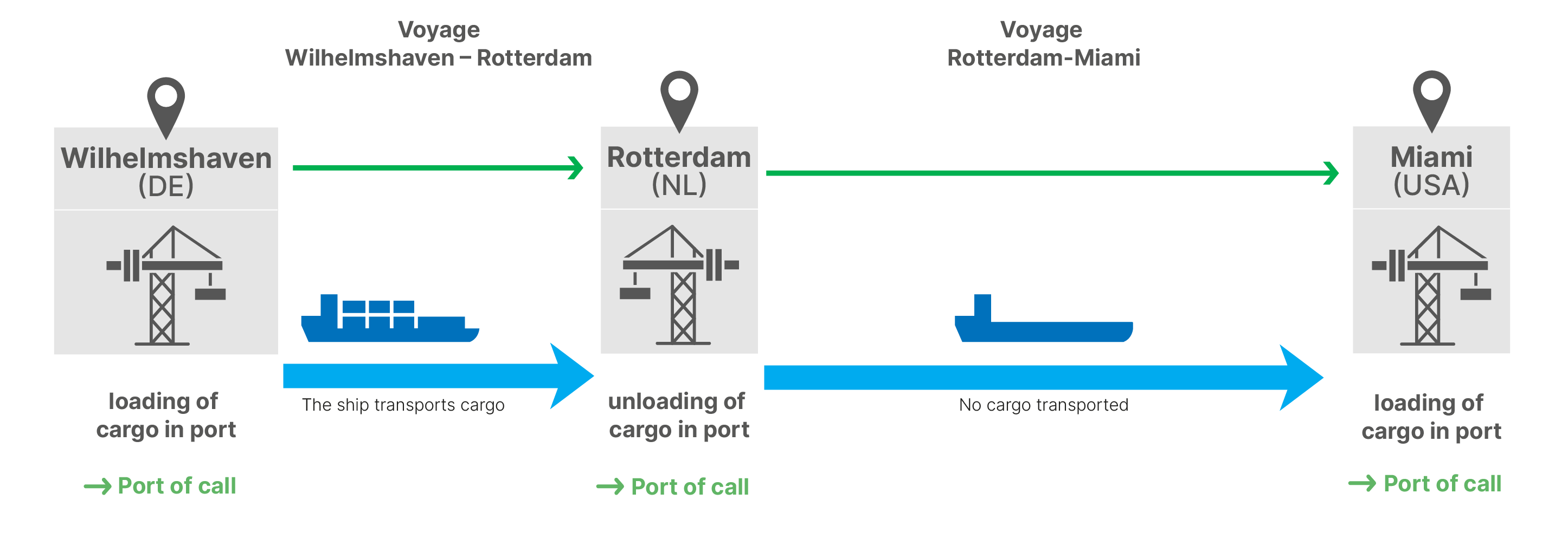
[ship to ship transfers] Are emissions from ‘ship to ship transfers’ carried out outside ports subject to the MRV Maritime Regulation?
‘Ship to ship’ transfers carried out outside ports are covered by the Regulation, when these transfers take place as part of a voyage starting and/or ending with a port of call under the jurisdiction of a Member State. Variations of cargo arising from ‘ship to ship’ transfers outside ports during a voyage should be taken into account. In those cases, a weighted average for cargo carried should be calculated and applied to the entire voyage.
[ship to ship transfers] Does a ship to ship transfer taking place outside of a port count as a port of call? To take an example, if a vessel leaves an EEA port, arrives in Houston (US) and performs ship to ship operation outside the Houston port limits and then goes to South Korea for a cargo operation within port limits, should the emissions for this voyage be considered from the EEA port up until South Korea?
A ship to ship transfer carried out outside ports is not considered as a port of call within the meaning of the MRV Maritime Regulation.
As a consequence, in the above example, yes: the emissions falling within MRV scope will be the emissions released during the whole voyage from the EEA port of call until the port of call in South Korea.
However, please note that if the ship to ship transfer would be carried out within Houston port limits, that operation would constitute a port of call. The voyage covered by the MRV Maritime Regulation would then be EEA port of call – Houston port of call.
[stops for drydock/repairs] How should stops of ships for repairs/dry-docking be considered for MRV purposes?
Stops for the sole purpose of going into dry-dock or making repairs to the ship and/or its equipment are not considered as ‘ports of call’ within the meaning of the MRV Maritime Regulation. This means that emissions falling within the MRV scope are those taking place during the voyage between the previous port of call and the next port of call, provided that at least one of these two ports of call is a port of call under the jurisdiction of a Member State. Emissions released during that voyage include emissions released during the stop for repairs/drydocking.
An example is provided below. The green arrow means that the emissions from the voyage fall within MRV scope.
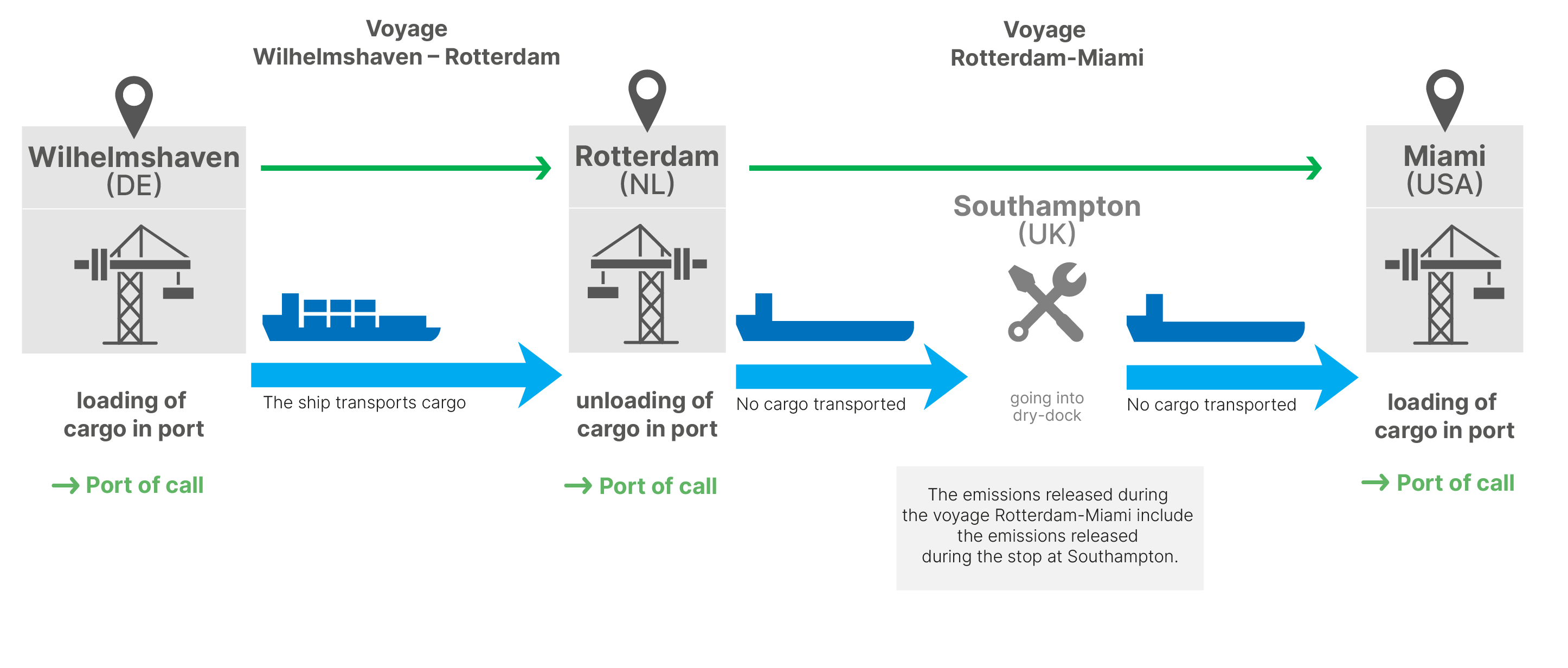
[Stops to relieve the crew] How should emissions be reported in case of a stop to relieve the crew? When is the start and end of the voyage for MRV purposes?
Stops for the sole purpose of relieving the crew are not considered ports of call within the meaning of the MRV Maritime Regulation, except for offshore ships.
As a consequence, emissions falling within the MRV scope are those taking place during the voyage between the previous port of call and the next port of call, provided that at least one of these two ports of call is a port of call under the jurisdiction of a Member State. Emissions released during that voyage include emissions released during the stop for relieving the crew.
An example is provided below (not applicable for offshore ships). The green arrow means that the emissions from the voyage fall within MRV scope.
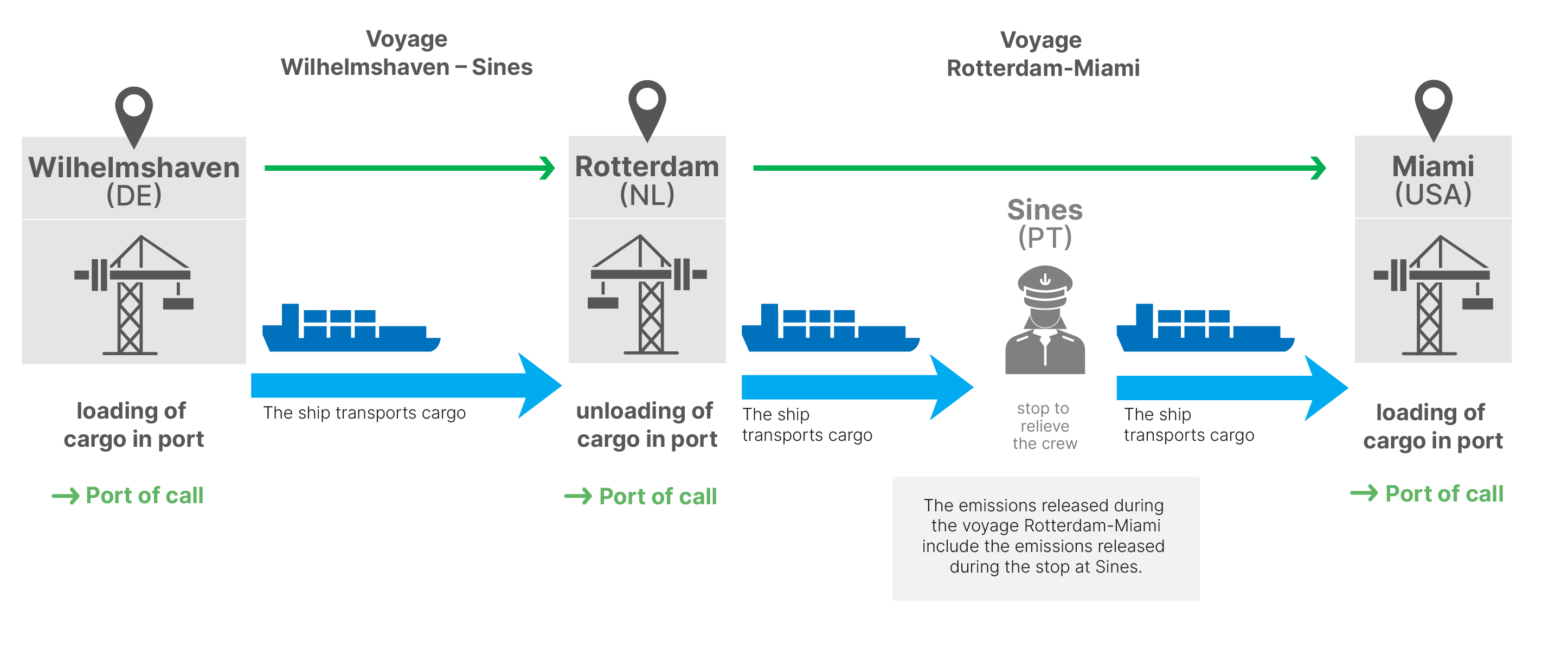
[Stops for refuelling purposes] How should stops for refuelling purposes be considered, and how emissions should be reported when there is such a stop?
Stops for the sole purpose of refuelling are not considered ports of call within the meaning of the MRV Maritime Regulation. As a consequence, emissions falling within the MRV scope are those taking place during the voyage between the previous port of call and the next port of call, provided that at least one of these two ports of call is a port of call under the jurisdiction of a Member State. Emissions released during that voyage include emissions released during the stop for refuelling purposes.
An example is provided below. The green arrow means that the emissions from the voyage fall within MRV scope.
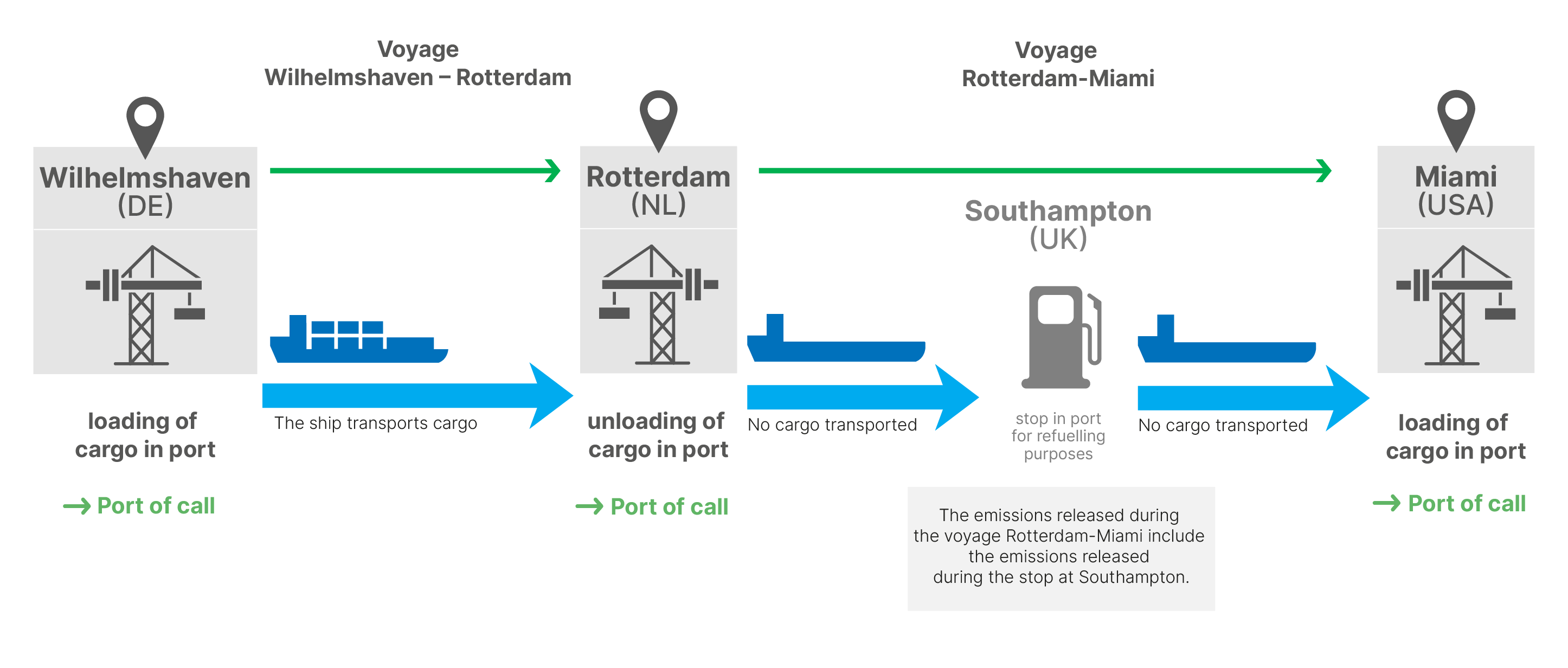
[stops in neighbouring container transhipment ports] Are stops in neighbouring container transhipment ports considered as ports of call? Do emissions within such ports fall within the scope of the MRV Regulation?
Stops by containerships at neighbouring container transhipment ports identified in the legislation as presenting a high risk of evasion (see Implementing Regulation (EU) 2023/2297) are not considered ports of call within the meaning of the MRV Maritime Regulation. Hence, they do not count to determine the start or the end of a voyage.
Emissions released during the voyage include emissions released during the stop at the neighbouring container transhipment port.
The Commission will reconsider every two years the container transhipment ports where the risk of evasion is the highest.
An example is provided below. The green arrow means that the emissions from the voyage fall within MRV scope.
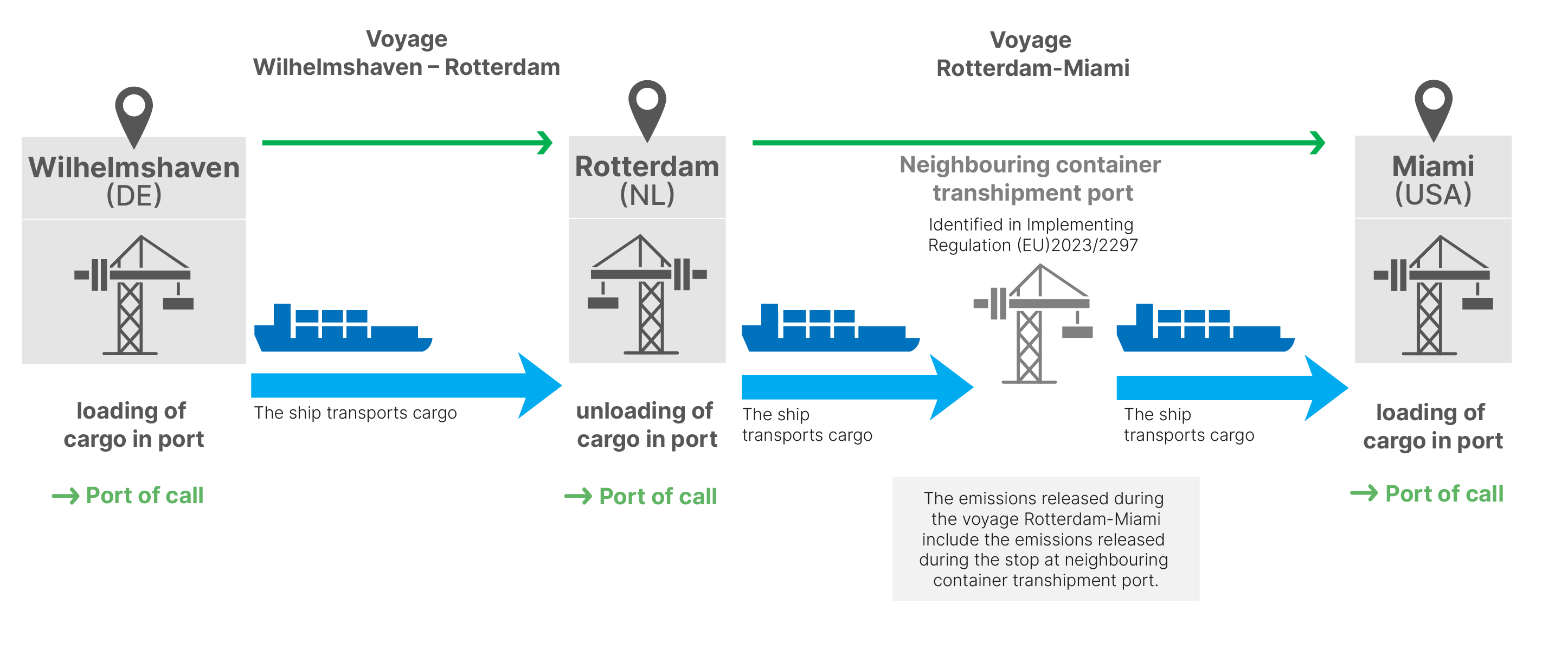
[first voyage from shipyard] Does the (first) voyage of a newbuilt ship from its shipyards to its first stop to load cargo or embark passengers fall within the MRV Maritime scope?
Provided that no cargo nor passenger are transported for commercial purposes during that voyage, the maiden voyage of a ship from its shipyards to its first port of call under the jurisdiction of a Member State is not covered by the MRV.
By contrast, if the ship transports cargo or passenger for commercial purposes during its maiden voyage, the voyage is covered by the MRV Maritime Regulation scope, provided that this maiden voyage starts and/or ends with a port of call under the jurisdiction of a Member State.
[decommissioning trip] Does the (last) voyage of an empty ship to the decommissioning facility fall within MRV Maritime scope?
The last voyage of an empty ship to the decommissioning facility is not covered by the MRV Maritime obligations.
Emissions within ports
Are greenhouse gas emissions within EEA ports covered? How must emissions within EEA ports be reported?
Greenhouse gas emissions that were released within EEA ports of call fall within the scope of the MRV Maritime Regulation.
Greenhouse gas emissions that were released at berth, within an EEA port of call, are covered and must be reported annually as a separate item in the emissions report.
Greenhouse gas emissions that were released within EEA ports when the ship is not at berth, but instead moving within a port of call between two voyages, must also be accounted for when reporting the greenhouse gas emissions which occurred within ports. In such a case, cargo and other related parameters such as ‘distance travelled’ or ‘cargo carried’ do not have to be monitored and reported.
When monitoring emissions pursuant to Article 10, point (k), of the MRV Maritime Regulation, the company must monitor and report all emissions within ports.
For a vessel loading cargo outside the EEA and performing a voyage to the EEA, when does the counting start: upon departure from the loading port, or should GHG emissions during loading in the port be included as well?
In that example, the start of the voyage is the last port of call before arriving to an EEA port. For MRV purposes, emissions should therefore be accounted for as from the moment when the ship is not at berth anymore.
Are the emissions occurring when the vessel is anchored within port limits and does not perform any embarkation or disembarkation of passengers, and then proceed to a quayside for passenger embarkation, part of the voyage emissions or part of the emissions within ports?
It depends on the sequence of ports of call. Emissions within a port of call are to be meant as the sum of emissions while at berth and emissions from movements in port. The latter are to be understood as emissions taking place within port limits but only when not included in a voyage. Indeed, emissions related to the entry (i.e., after passing the port’s limits) or exit from ports (i.e., before passing the port’s limits) are part of the voyage scope, as they occur before or after the port of call. In other words, the mere fact of entering or leaving port limits does not mark the end or beginning of a voyage. Consequently, emissions within a port of call can only start or end after a port of call (e.g., for embarking or disembarking passengers), since that moment marks the end or the beginning of a voyage.
Geographical scope
What does the expression “port of call under the jurisdiction of an EU Member State” mean? Are all Member State ports covered? Are ports in Iceland and Norway covered?
The expression "ports of call under the jurisdiction of a Member State" refers to ports of call located in European Union territory, (in other words, where EU law fully applies). Not all ports belonging to an EU Member State are EU territories (see list below). For a voyage to be covered by the MRV Maritime Regulation, at least one of the ports of call must be located in an EU territory.
Ports of call in the nine EU outermost regions are EU ports of call:
-
-
-
- Azores
- Madeira
- Canary Islands
- Guadeloupe
- French Guyana
- Martinique
- Mayotte
- Saint Martin
- Reunion
-
-
Ports of call in Norway (except those on Svalbard) and Iceland also qualify as ports of call under the jurisdiction of a Member State, since the MRV Maritime Regulation and the ETS Directive are incorporated into the EEA Agreement (Annex XX).
EEA Member States' Overseas Countries and Territories (‘OCT’) which do not qualify as ports of call under the jurisdiction of a Member State are:
-
-
-
- Aruba
- Bonaire
- Curaçao
- French Polynesia
- Greenland and the Faroe Islands
- New Caledonia
- Saba
- Saint Barthélemy
- Saint Pierre and Miquelon
- Sint Eustatius
- Sint Maarten
- Svalbard
- Wallis and Futuna
-
-
In addition, please note that stops in Faroe Islands do not qualify as ports of call under the jurisdiction of a Member State.
In practical terms, this implies that:
-
-
-
- voyages between a port of call located on the territories above, the Faroe Islands or Svalbard and a port of call under the jurisdiction of a Member State constitute "incoming"/ "outgoing" voyages and are to be monitored and later reported;
- voyages between two ports of call located on the territories above, the Faroe Islands or Svalbard, do not fall under the MRV Maritime Regulation.
-
-
Does the MRV Maritime Regulation apply to Norway and Iceland?
The MRV Maritime Regulation applies to Norway and Iceland. This Regulation is incorporated into the EEA Agreement (Annex XX).
Monitoring, reporting and verification obligations
Who assumes the monitoring, reporting and verification obligations for each ship?
Shipping companies are responsible for complying with the monitoring and reporting of verified emissions of each ship under their responsibility (most MRV obligations apply in respect of individual ships).
Shipping companies need to submit for assessment a monitoring plan for each of the ships under their responsibility to an independent accredited verifier. For ships whose emissions are falling within the scope of the ETS Directive, the monitoring plan must also be submitted to the administering authority responsible for approval after it has been assessed by the verifier.
What obligations does the MRV Maritime Regulation impose on companies and by when?
For each of their ships carrying out voyages to and/or from ports under the jurisdiction of a Member State after 1 January 2024, companies must fulfil the following monitoring and reporting obligations:
-
-
-
- Revise the monitoring plan of each of their ships to be in in conformity with the requirements of the revised MRV Maritime Regulation. This plan must be assessed as being in conformity by an independent verifier before 1 April 2024, or no later than three months after each ship’s first call in a port under the jurisdiction of a Member State.
- By 1 April 2024, or no later than three months after each ship’s first call in a port under the jurisdiction of a Member State, companies must, for each of their ships falling within the scope of the ETS Directive, submit to the administering authority a monitoring plan that has been assessed as being in conformity with the MRV Maritime Regulation by an accredited verifier and that reflects the inclusion of CH4 and N2O emissions within the scope of the MRV Maritime Regulation.
- From 1 January 2024, companies must monitor and report methane (CH4) and nitrous oxide (N2O) emissions, in addition to CO2 emissions.
- From 2025, by 31 March of each year, companies must, for each ship under their responsibility, submit an emissions report for the entire reporting period of the previous year, which has been verified as satisfactory by a verifier, to:
-
-
-
-
-
-
- the administering authority in respect of the shipping company (for ships falling within the scope of the ETS Directive);
- the authorities of the flag States concerned for ships flying the flag of a Member State;
- and the European Commission.
-
-
-
-
-
-
- The administering authority may require companies to submit their emission reports earlier than 31 March, but not earlier than by 28 February.
- From 2025, by 31 March of each year, for ships falling within the scope of the ETS Directive, companies must submit aggregated emissions data at company level (see FAQ on ETS for maritime for more information).
-
-
What about ships that do not carry out any voyage falling under the MRV Maritime Regulation during a full calendar year?
A ship that has not carried out any EEA-related voyages during a whole reporting period (calendar year) will not be required to submit a verified emissions report under the terms of Article 11 of the MRV Maritime Regulation. The ship will not be required by Member States' authorities to have a Document of Compliance on board as a proof of compliance for that specific reporting period, when calling at EEA ports between 30 June of the following year and 29th June of the year after.
As of when should companies submit ‘partial’ emissions reports to the new company in case of change of company, and what are the obligations related to this?
The amendments to the MRV Maritime Regulation related to ‘partial’ emissions reports, introduced by Regulation (EU) 2023/957, entered into force on 5 June 2023. As a consequence, if a change of company occurred after this date, the previous company shall produce a verified report covering the same elements as the (annual) emissions report but limited to the period corresponding to the activities carried out under the company’s responsibility (‘partial emissions report’) during the reporting period.
Such partial emissions reports shall be submitted to the new company, the flag State, the administering authority responsible (as of January 2024 only and if the ship falls within ETS scope) and the Commission. It shall be done through THETIS-MRV. Please note that a partial emissions report cannot be submitted via THETIS-MRV anymore for a ship once that ship has been released from the company’s fleet. The release of the ship in THETIS-MRV should therefore happen after the submission of the partial emissions report.
In case the registered owner becomes the responsible entity for MRV (and ETS) purposes during a reporting period, instead of the previous ISM company, is there an obligation for the ISM company to provide a partial emissions report?
Yes. According to the revised MRV Maritime Regulation, anytime a change of company occurs (which is the case in the example above), the previous company shall produce a verified report covering the same elements as the (annual) emissions report but limited to the period corresponding to the activities carried out under the company’s responsibility (‘partial emissions report’).
In case the registered owner becomes the responsible entity for MRV (and ETS) purposes during a reporting period, instead of the previous ISM company, is there an obligation for the shipowner to provide a revised Monitoring Plan?
Yes. In accordance with Article 7 of the MRV Maritime Regulation, a company shall modify the monitoring plan where a change of company occurs. If, apart from that change, there are no other changes in the monitoring plan of the ship, the modified monitoring plan does not need to be re-assessed by verifiers: the modified monitoring plan simply needs to be sent to the administering authority responsible for approval.
How should emissions for the 2023 reporting period be monitored, reported, and verified? Do the new templates and verification rules already apply to 2023 emissions data?
No. Emissions data for the 2023 reporting period should be monitored, reported, and verified in accordance with the rules that were applicable so far, before the entry into force of the implementing and delegated acts that followed the revisions of the ETS Directive and MRV Maritime Regulation. The applicable templates for the 2023 emissions are available here.
The revised templates indeed relate to monitoring, reporting and verification activities related to greenhouse gas emissions released from 1 January 2024 only (not before).
What happens if a trip takes place during two reporting periods (e.g., starting in December 2024 and ending in February 2025)?
A reporting period is the period from 1 January until 31 December of any given calendar year. Hence, for voyages starting and ending in two different calendar years, the respective data must be accounted under each reporting period. Following the example above, this means that the amount of emissions until 31 December 2024, as monitored by the shipping company, will be reported as part of the 2024 emissions report, while the amount of emissions corresponding to the part of the voyage as of 1 January 2025 will be accounted for in the 2025 emissions report.
The same reasoning applies for emissions from a voyage that starts in 2023 and ends in 2024. The emissions corresponding to the part of the voyage as of 1 January 2024 shall be accounted for in the 2024 emissions report only.
Are companies obliged to monitor and disaggregate fuel consumption by each emissions source starting from the reporting period 2024?
Companies are required to monitor and disaggregate fuel consumption on a per emissions source basis only if they apply emissions source specific emissions factors. In accordance with Annex I to the MRV Maritime Regulation (as amended, available here) that is the case for:
1. emissions sources consuming LNG (being fossil LNG, bio-LNG, or e-LNG), in which case different slippage coefficients may apply
2. emissions sources consuming H2 (being fossil H2, bio- H2 or e- H2), in which case different N2O emissions factors may apply.
When are physical site visits by verifiers mandatory?
According to the draft Delegated Regulation, subject to the two-month scrutiny by the European Parliament and the Council until 21 December 2023 (see here), and to be published by the end of 2023, a physical site visit is mandatory only for the verification of emissions reports in case no physical site visit has been carried out in the three reporting periods immediately preceding the current reporting period. The three-year period shall refer to three consecutive reporting periods that start after 1 January 2024. In other words, there is an obligation to carry out a physical site visit for the verification of emissions reports of a ship at least once every four years, starting in 2024.
Please note that the location(s) of the site visit is/are to be determined by the verifier on the basis of the results of the risk analysis and after taking into consideration the place where the critical mass of relevant data is stored, and the place where data-flow activities and control activities are carried out. In other words, a physical site visit does not necessarily entail a visit onboard the ship; instead, the location of the site visit could be e.g., the headquarters of the company.
In addition, if conditions are met, the verifiers may also carry out virtual site visits or waive the site visit. Please note that carrying out a virtual site visit is not considered as waiving a site visit.
Must companies submit a monitoring plan for each ship under their responsibility?
Yes. The monitoring plan reflects the technical specifications and the monitoring methods to be applied to the voyages carried out by the ship concerned and which fall under the MRV Maritime Regulation. It is prepared by the company having assumed the MRV responsibilities for this specific ship.
However, to simplify the process, shipping companies can identify when submitting information to an accredited verifier:
-
-
-
- the information which applies in an identical manner to their entire fleet ('company-specific parts');
- the information which reflects the ship's technical characteristics and specific procedures (ship specific parts).
-
-
Shipping companies must use standardised monitoring plans based on templates determined by the Commission. The monitoring plans need to be submitted through THETIS-MRV.
What is the process for the submission of monitoring plans to the verifier?
Companies are to draft and submit the monitoring plans to accredited verifiers through the THETIS-MRV platform.
Monitoring plans can be established in any language agreed between the company and the accredited verifier. However, there is an obligation to ensure that an English translation of the satisfactorily assessed monitoring plan is available.
The verifier must assess the conformity of the monitoring plan with the requirements laid down in the MRV Maritime Regulation. Where the verifier's assessment identifies non-conformities with those requirements, the company concerned shall revise its monitoring plan accordingly and submit the revised plan for a final assessment by the verifier before the reporting period starts. The company shall agree with the verifier on the timeframe necessary to introduce those revisions. That timeframe shall in any event not extend beyond the beginning of the reporting period.
What is the minimum content and format of the monitoring plan?
Companies must draft monitoring plans in the THETIS-MRV system, on the basis of a template defined in Annex I to the Implementing Regulation (EU) 2023/2449 (new template). Information concerning all mandatory items, as identified in the monitoring plan template, has to be included.
Additionally, there are a number of voluntary fields that might be relevant for a limited number of ship categories. For example:
-
-
-
- the ice class of the ship (unless the ship wants to benefit from the specific ETS derogation for ice-class ships, in which case this information is mandatory) and procedures, responsibilities, formula and data sources for determining and recording the distance travelled and the time spent at sea when navigating through ice, if applicable, and
- other procedures relevant to monitoring of fuel consumed and CO2 emitted such as the procedures for determining and recording the fuel consumption for dynamic positioning, or the average density of cargo transported.
-
-
Information on procedures and other elements included under the voluntary fields on the monitoring plan is also part of the assessment by the verifier.
The drafting of the monitoring plan in accordance with the new template can be done either by filling in the online form in THETIS-MRV (that will be deployed as of January 2024) or by uploading files in THETIS-MRV in accordance with the new template and IT format (that is made available in the FAQ of THETIS-MRV).
Can companies modify the monitoring plan?
Companies are required to check at least once a year whether a ship’s monitoring plan reflects the nature and functioning of the ship and whether the monitoring methodology can be improved. The MRV Maritime Regulation provides for certain situations when companies are required to modify the monitoring plan, such as:
-
-
-
- a change of company;
- new greenhouse gas emissions are generated due to new emission sources or due to the use of new fuels not yet contained in the monitoring plan;
- a change in availability of data which may affect the accuracy of the measurement of greenhouse emissions, due to the use of new types of measuring equipment, new sampling methods or analysis methods or other reasons;
- data resulting from the monitoring method has been found to be incorrect;
- any part of the monitoring plan is identified as not being in conformity with the requirements of the MRV Maritime Regulation.
-
-
In case of modifications of the monitoring plans, companies shall notify the verifiers without undue delay.
In circumstances provided by points (2), (3) and (4), modifications of the monitoring plan shall be subject to assessment by the verifier. Following the assessment, the verifier shall notify the company whether those modifications are in conformity.
Once a company has received a notification of conformity, and for ships falling within the scope of the ETS Directive, the company shall submit its modified monitoring plan to the responsible administering authority. Companies shall also submit modifications provided under points (1) and (5) to the responsible administering authority.
The administering authority responsible shall approve modifications of the monitoring plan.
Do shipping companies need to upload the Monitoring Plan to the THETIS-MRV platform?
Yes, as of 1 January 2024, the monitoring plan will need to be submitted through THETIS-MRV.
Under which conditions can a ship benefit from the exemption from the 'per voyage' monitoring?
A company is exempt from the obligation to monitor a specified ship on a per-voyage basis, if according to schedule:
-
-
-
- all of the ship's voyages during the reporting period are EEA-related voyages and
- the ship performs more than 300 voyages during the reporting period.
-
-
Both conditions need to be met.
In practical terms, it implies that providing data to the verifier on per voyage monitoring is not compulsory to the extent that other documents and data (such as Bunker Delivery Notes) could be used to calculate the ship's aggregated data.
Companies have to document their procedures to calculate aggregated data in the monitoring plan, using the official template.
However, please note that where emissions would fall under the scope of any of the specific ETS derogations (provided for in Article 12(3-b), 12(3-c) or 12(3-d) of the ETS Directive), companies might need to monitor on a per-voyage basis, although these specific rules are being developed as part of implementing and delegated acts to be adopted by the end of 2023 (more information will follow soon). Article 12(3-b), 12(3-c) or 12(3-d) of the ETS Directive provide for specific derogations related to, respectively, outermost regions, certain transnational maritime routes under public service contract or obligation, and specific small islands with no road or rail link with the mainland and with a population of fewer than 200 000 permanent residents (see the FAQ on ETS maritime for more information).
Who provides accreditation for verification activities?
National Accreditation Bodies (NABs) are the sole competent bodies in EEA Member States that can grant accreditation to legal entities performing verification activities pursuant to the MRV Maritime Regulation.
To which NAB must EEA legal entities address their request for accreditation as MRV shipping verifiers?
As a general rule, legal entities established in the EEA must request accreditation from the national accreditation body of the Member State in which they are established, or from the national body to which that Member State has had recourse. Only under exceptional circumstances (see Regulation 765/2008), can an EEA legal entity request accreditation by a different NAB, for instance where the national accreditation body has not successfully undergone peer evaluation in respect of the conformity assessment activities for which accreditation is sought.
What about non-EU legal entities' requests for accreditation as verifier?
Non-EU legal entities have a choice to introduce a request in any of the European national accreditation bodies providing for accreditation for MRV shipping activities.
What is the accreditation process about?
As part of the accreditation process, the competent NAB carries out an assessment of whether all the requirements on verification and accreditation pursuant to the MRV Maritime Regulation and in EN/ISO 14065 have been met. The assessment process will include a review of the relevant documents, office visit(s), and one or more witness audits of the performance and competence of the verifier's staff. As a result, an accreditation certificate will be issued to the legal entity.
There might be differences in the process carried out by each NAB so please refer to the competent NAB as soon as possible so as to prepare for a timely start of the accreditation process. Also, planning of the accreditation process has to be agreed upon between the legal entity seeking accreditation and the competent NAB.
Where can companies check which legal entities have received accreditation as MRV shipping verifiers?
National accreditation bodies (NABs) are to set up and manage a public database which includes information on at least:
-
-
-
- the name, accreditation number and address of each verifier accredited by that NAB;
- the date on which the accreditation or certification was granted and its expiry date; and
- information on administrative measures that have been imposed upon the verifier.
-
-
Can companies select any accredited verifier to carry out verification for any of their ships?
Companies can select any duly accredited verifier irrespective of the ship's flag or the place where the company is based and where the accredited verifier is based. However, the verifier must be independent from the company and impartial in carrying out its verification activities.
Can MRV shipping accredited verifiers work for any company?
An accredited verifier can perform verification activities for any ship falling under the MRV Maritime Regulation, irrespective of where the company is based, of where the ship is registered and of where the verifier itself is based. However, verification activities for a company in respect of which the verifier has a conflict of interest or pose an unacceptable risk to their impartiality are not possible.
When must the verifier be accredited?
A verifier must be accredited by the time it issues its conclusions on monitoring plans or on emissions reports.
The Commission and the European Maritime Safety Agency are available to answer any queries from stakeholders in relation to the new requirements under the revised MRV Maritime Regulation and the EU ETS Directive. Please contact fitfor55@emsa.europa.eu for any question you may have.


